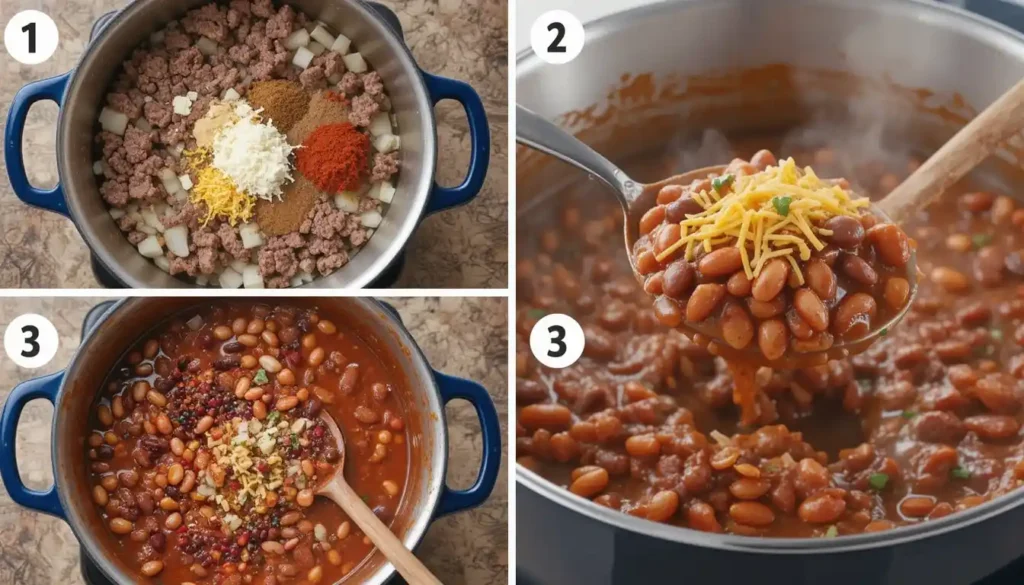Table of Contents
Imagine a warm, comforting bowl of chili on a chilly evening, made effortlessly in the comfort of your own kitchen. With a rich, complex flavor profile and a prep time of under an hour, this dish is perfect for weeknight dinners. You can enjoy it alongside Homemade Cornbread, buttered toast, or Buttermilk Biscuits, customized with your favorite toppings like cheese and onions.
This classic homemade recipe is not only delicious but also easy to prepare, making it a staple for any home cook. The perfect balance of ground beef, beans, tomatoes, and spices creates a hearty meal that satisfies hunger. What’s more, this dish is highly versatile, allowing you to adjust the ingredients to suit different tastes and dietary preferences.

What Makes a Great Chili
To create a truly exceptional chili, you need to strike the right balance between various flavors. A great chili is a harmonious blend of savory beef, hearty beans, acidic tomatoes, and aromatic spices. The combination of these ingredients creates a complex flavor profile that is both satisfying and delicious.
The Perfect Balance of Flavors
Achieving the perfect balance between heat, sweetness, acidity, and umami is crucial. The spices, including chili powder and cumin, play a vital role in this balance. For instance, mixing chili powder into raw ground beef ensures every morsel is seasoned to perfection. The blend of flavors develops depth and richness in your recipe.
| Ingredient | Contribution to Flavor |
|---|---|
| Ground Beef | Savory, rich flavor base |
| Beans | Hearty texture and subtle sweetness |
| Tomatoes | Acidity and a burst of freshness |
| Spices (Chili Powder, Cumin) | Aromatic depth and warmth |
Why This Recipe Works
This recipe works exceptionally well due to its straightforward approach and reliable results. The slow simmering process allows the flavors to meld together, intensifying the overall taste of the chili. By layering flavors throughout the cooking process, you develop a rich and satisfying dish that’s sure to please.
Essential Ingredients for Classic Chili Recipe
A classic chili recipe relies on a few fundamental ingredients that provide its characteristic flavor and texture. The beauty of chili lies in its simplicity and the quality of its components.

The Protein Base: Ground Beef Options
The foundation of a classic chili is often ground beef. You can choose between lean and higher fat content ground beef. Lean ground beef will result in a slightly healthier chili, while higher fat content will make it more flavorful and tender. The choice depends on your preference.
Beans: Types and Preparation
Kidney beans are a staple in many chili recipes, but you can also use pinto or black beans. It’s essential to rinse canned beans before adding them to your chili to remove excess salt and starches. If you’re using chili beans, which are beans cooked in a chili-style sauce, you can skip rinsing as they add extra flavor.
Tomato Components
Tomatoes are crucial for chili’s flavor. You can use diced tomatoes, tomato paste, or crushed tomatoes. Diced tomatoes add texture, while tomato paste provides a concentrated tomato flavor. Crushed tomatoes offer a smoother consistency.
Aromatics and Vegetables
Onion and garlic are the aromatic vegetables that form the flavor foundation of good chili. They add depth and warmth to the dish. Make sure to sauté them properly to bring out their natural sweetness.
Here’s a summary of the essential ingredients in a table format:
| Ingredient | Type/Options | Purpose |
|---|---|---|
| Ground Beef | Lean or Higher Fat Content | Protein Base |
| Kidney Beans | Canned or Cooked from Scratch | Adds Fiber and Protein |
| Tomatoes | Diced, Crushed, or Paste | Provides Flavor and Texture |
| Onion and Garlic | Fresh or Powdered | Aromatic Flavor Base |
The Spice Blend: Creating Depth of Flavor
A well-crafted spice blend is essential for achieving the perfect balance of flavors in your chili. The seasonings in this recipe are primarily chili powder and cumin, which work together to create a rich and complex flavor profile.
Essential Spices for Authentic Chili
Chili powder is a cornerstone of chili recipes, and it can be either store-bought or homemade. A typical chili powder blend includes sweet paprika, garlic powder, cayenne pepper, onion powder, oregano, and cumin. These ingredients come together to create a deep, slightly spicy flavor that defines authentic chili.
Customizing Heat Levels
For those who prefer a spicier chili, there are several options to increase the heat. You can leave the seeds in your jalapenos, add a few dashes of hot sauce, or sprinkle some chili flakes into the pot. On the other hand, if you prefer a milder flavor, you can reduce or omit the cayenne pepper and chili flakes.
| Spice | Function | Adjustment for Taste |
|---|---|---|
| Chili Powder | Provides the base flavor | Increase for more depth |
| Cayenne Pepper | Adds heat | Reduce or omit for less heat |
| Paprika | Adds sweetness and color | Adjust to change the color and sweetness level |
Step-by-Step Cooking Instructions
Now that we have covered the essential ingredients, let’s dive into the step-by-step cooking instructions for this delicious chili recipe. Cooking chili is a straightforward process that requires some attention to detail to achieve the perfect flavor and texture.

Preparing Your Ingredients
Before you start cooking, make sure to prep all your ingredients. This includes dicing onions and garlic cloves, measuring out spices, and having your ground beef ready. Proper preparation ensures a smooth cooking process.
Browning the Meat and Aromatics
In a large pot, brown the ground beef over medium-high heat, breaking it up into small pieces as it cooks. This should take about 5-7 minutes. Add diced onion and minced garlic to the pot and continue cooking until the onion is translucent.
Adding Spices and Liquids
Once the meat and aromatics are cooked, add the remaining spices, tomato components, and beans to the pot. Stir well to combine.
Simmering to Perfection
Bring the chili to a simmer, then reduce the heat to low and let it cook uncovered for 30-60 minutes. This allows the flavors to meld together and the chili to thicken naturally. As stated by a renowned chef, “The key to a great chili is in the simmering.” Simmering uncovered is crucial as it allows excess moisture to evaporate, resulting in a thicker, more flavorful chili.
Pro Tips for the Best Homemade Chili
To take your chili recipe to the next level, consider these expert tips. Creating exceptional chili requires attention to detail and a few insider secrets.
Thickening Your Chili Naturally
One of the key factors in making great chili is achieving the right consistency. Simmering your chili uncovered on the stovetop allows it to thicken naturally, concentrating the flavor in the process. If you’re short on time, you can use a little cornmeal or create a cornstarch slurry as an alternative thickening method.
Balancing Flavors
Balancing the fundamental flavor components—sweet, salty, acidic, and spicy—is crucial for perfect taste. Adjusting seasonings like salt and cayenne towards the end of cooking helps fine-tune your chili‘s flavor profile. Taste throughout the cooking process to ensure your beef and beans are well-seasoned, and the overall taste is balanced.
By following these pro tips, you’ll be able to create a rich, flavorful chili that’s sure to please. Whether you’re cooking in a large pot or adjusting the seasoning, these expert suggestions will help you achieve the best homemade chili recipe.
Delicious Variations to Try
Breathe new life into your chili recipe by exploring alternative proteins, beans, and spices. You can easily customize your chili to suit your taste preferences.
Protein Alternatives
You can use various types of ground meat in your chili recipe, such as chicken or turkey. If you choose a fattier meat, be sure to drain the excess fat before simmering to avoid a greasy texture.
Bean Variations
While kidney beans are a classic choice, you can experiment with other types of beans like black beans, pinto beans, or white beans to change the flavor and texture of your chili.
Liquid Additions for Extra Flavor
Adding different liquids can enhance the flavor of your chili. Consider using beer or various broths to add depth. You can also use tomatoes or tomato-based products for added richness.
Vegetable Add-ins
Incorporating veggies like bell peppers, corn, or sweet potatoes can not only add flavor but also increase the nutritional value of your chili. Feel free to get creative with your chili recipe by adding your favorite veggies or using different spice blends and powder combinations.
Perfect Toppings for Your Chili
Elevate your chili experience with the perfect toppings that transform a simple bowl into a personalized meal. The right toppings can add a new dimension to your chili, making it even more enjoyable.
Classic Toppings
Some toppings have stood the test of time, becoming staples for a reason. Shredded cheddar cheese is a favorite, adding a rich, creamy element to your chili. A dollop of sour cream can provide a cool contrast to the warm, spicy flavors. Diced onion adds a punch of flavor and texture. These classic toppings are a great starting point for customizing your bowl.
Creative Topping Ideas
For those looking to venture beyond the classics, consider adding some diced avocado for creaminess, a sprinkle of fresh cilantro for freshness, or a squeeze of lime juice for a burst of citrus. You can also add some heat with diced jalapenos or a sprinkle of crushed tortilla chips for crunch. The possibilities are endless, allowing you to tailor your chili to your taste.
| Topping | Description | Flavor Addition |
|---|---|---|
| Sour Cream | Creamy dollop | Cooling contrast |
| Cheddar Cheese | Shredded or sliced | Rich, creamy |
| Diced Onion | Raw or caramelized | Pungent flavor |
| Avocado | Diced or sliced | Creamy texture |
By offering a variety of toppings, you can turn a simple chili meal into a fun and interactive dining experience. Whether you’re hosting a party or just cooking for your family, a well-stocked topping bar is sure to be a hit.
What to Serve with Chili
The key to a delightful chili experience lies in selecting the ideal accompaniments to complement its rich flavors. Serving the right food alongside your chili recipe can elevate the meal to a whole new level.
Bread and Cornbread Options
Cornbread or plain toast with butter is a classic combination that works wonders. You can also consider 30 Minute Dinner Rolls for a delicious and easy-to-make option. These bread options are perfect for sopping up the flavorful sauce of your chili.
Side Dishes That Complement Chili
To stretch out the meal, consider serving your chili recipe over white rice. Other side dishes like simple green salads or coleslaw can provide a refreshing contrast to the hearty chili. Choose lighter options for summer or heartier sides for winter to adapt to the season.
Storing and Reheating Your Chili
Proper storage and reheating techniques are essential to enjoying your chili over time. You can enjoy your chili for days to come if you store it correctly.
Refrigeration Tips
To store chili in the fridge, cool it down quickly and safely before refrigerating. You can keep it in the fridge for up to 5 days. Chili often tastes even better the next day as the flavors meld together.
Freezing Methods
For longer storage, you can freeze your chili. Freeze it in single-sized portions for easy lunches or in freezer bags for a quick weeknight meal. When you’re ready to eat it, defrost it in the fridge overnight.
Reheating for Best Results
To reheat, use a saucepan or the microwave. If using the microwave, heat in one-minute intervals, stirring between each, until heated through. You can also reheat it on the stovetop over low heat. Adjust the seasoning as needed after reheating.
Conclusion: Why This Chili Recipe Will Become a Family Favorite
This beloved beef chili recipe has been a favorite among my readers for over a decade, and for good reason. It offers a perfect balance of flavors and is incredibly easy to make, making it a staple for any family meal. The versatility of this classic chili recipe allows you to customize it to your taste, whether you prefer more heat or different ingredients.
Not only is this beef chili a comfort food that brings people together, but it’s also a nutritious, protein-rich meal that’s complete in a single bowl. I encourage you to try this recipe, experiment with it, and make it your own family tradition. With its rich flavors and numerous benefits, this chili recipe is sure to become a favorite in your household.
FAQ
Can I make this chili recipe with ground turkey instead of ground beef?
Yes, you can substitute ground turkey for ground beef. Keep in mind that the flavor and texture may be slightly different, but it will still be delicious. You may need to adjust the cooking time and seasoning accordingly.
How can I adjust the heat level of this chili recipe to suit my taste?
You can customize the heat level by adding more or less cayenne pepper, or by using hot sauce to taste. If you prefer a milder chili, you can omit the cayenne pepper or reduce the amount used.
Can I use canned kidney beans or do I need to cook dried kidney beans?
You can use either canned or cooked dried kidney beans. Canned beans are convenient and save time, while cooking dried beans from scratch can provide a slightly better texture and flavor.
What are some good toppings to serve with this chili recipe?
Popular toppings include shredded cheddar cheese, sour cream, diced onions, and sliced avocado. You can also try other toppings like diced tomatoes, shredded lettuce, or crushed tortilla chips.
Can I make this chili recipe in a slow cooker instead of on the stovetop?
Yes, you can adapt this recipe for a slow cooker. Brown the meat and cook the aromatics in a pan, then transfer everything to the slow cooker and cook on low for 6-8 hours.
How long can I store leftover chili in the fridge?
You can store leftover chili in the fridge for up to 3-4 days. Make sure to cool it down to room temperature before refrigerating, and reheat it to an internal temperature of 165°F before serving.
Can I freeze this chili recipe for later use?
Yes, you can freeze chili for up to 3-4 months. Cool it down to room temperature, then transfer it to airtight containers or freezer bags. Reheat it to an internal temperature of 165°F before serving.


1 thought on “Delicious Chili Recipe: Easy to Make at Home”
Comments are closed.